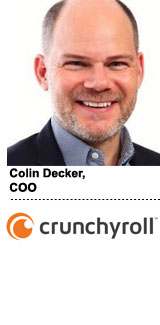
For video service Crunchyroll, finding the right mix of ads and subscriptions is critical for ensuring long-term success in the OTT space.
That strategy also includes a range of alternative revenue streams, such as offline events and ecommerce.
But before it could effectively monetize, Crunchyroll built a scaled audience by catering exclusively to Japanese anime enthusiasts.
As a result, the niche streaming service continued to attract funding from its investors. Ellation, Crunchyroll’s parent company, is backed by Otter Media, a joint video venture between AT&T and Chernin Group.
“Brands like ours, and maybe the WWE, have proven that serving a key audience and knowing exactly who you’re creating content for doesn’t have to be a niche effort,” said Colin Decker, COO of Crunchyroll and former GM of Discovery Digital. “That’s what made us one of the top 10 SVOD services in the world with a larger direct-to-consumer business than most US TV brands.”
In 2017, Crunchyroll crossed the 20 million-user milestone – and 1 million paid subscribers.
Decker spoke with AdExchanger about how Crunchyroll achieved its growth and where it’s heading.
AdExchanger: How does maintaining a direct-to-consumer model pay off for an OTT brand?
COLIN DECKER: The business I ran at Discovery Digital Networks was absolutely about expanding our own, original IP in a social sharing and distribution model. We were fully ad-supported.
Coming to Crunchyroll, which had such a unique subscription-based relationship with its users, allowed us to anchor the brand and a business and then build a strong, profitable model off of that. There are a lot of incremental and ancillary businesses you can develop if you have a strong brand.
Can you share an example?
It gives us permission to do a lot of other things that we probably wouldn’t have done in a purely ad-supported business. For instance, events – we just launched the Crunchyroll Expo, our own anime conference. We have Crunchyroll movie night, which happens four times a year in 300 theatres around the US. We have the Anime Awards, which is like the Oscars for anime. We lean very hard into commerce, have an ecommerce store and do a lot more merchandising at our live events now.
How do those ancillary events build audience engagement?
Crunchyroll kind of uniquely organized itself around an underserved category of people out there and over time, the aggregate momentum of that group became something bigger than the community, and it became more of a lifestyle and point of view. Instead of us just finding random anime fans around the world, we’re making new fans and showing them how great this medium is and what it means to be part of it.
You’re one of those rare video services that’s grown both your subscription and ad-supported businesses. What made you choose to do a hybrid?
In a purely ad-supported environment, you’re fairly dependent on the platforms you’re building audience on, which you do not own. There have been very few people who’ve been able to meaningfully build an owned-and-operated ad-supported business that’s capable of true scale, because the real audience scale fundamentally lives on big social platforms, especially Facebook and Google’s YouTube.
An important question for anyone to ask in the TV environment today when considering launching a new offering into the marketplace is, “Does your proposed offering uniquely speak to someone out there or does it attempt to reach everyone?” And that sheds a light on the fundamental issue we see, which is that a lot of content brands who try to be something to everyone, come from the legacy of traditional distribution – the MVPD world.
How does a legacy broadcaster find similar success in OTT then?
It’s a combination of things: a deep, committed empathy with the audience you’re trying to serve and then fact-checking yourself with actual data, whether it’s consumption data in your own platform or, in our case, lots of social data because it’s important to know what’s happening with the anime conversation outside of our own world.
We also don’t wake up in the morning thinking of new ways to make money. We wake up thinking of new ways to absolutely super-serve and engage our fans. That’s always the formula we start with.
How can a digital (or traditional) publisher find success in OTT when they’re often at the mercy of the platforms to increase their distribution?
Be reasonable in your expectations, be prepared to devote the time that it takes and be prepared with the capital to support you through that transition. It takes time.
Crunchyroll has been around for about 10 years, but the hockey stick really happened within the last two years. A huge pitfall for a lot of OTT services right now is having unrealistic expectations about how quickly they can create a direct-to-consumer relationship.
We were big fans of (Comcast’s) Seeso and partnered with them (before they were shut down). They had 100,000 subscribers, which is nothing to sneeze at, but you’re often punished if you don’t get to 1 million in year one. So, I’d say have patience, commitment and capital.
Also, absolutely know your audience. When Crunchyroll was a small startup, the people who worked here were the audience. And so it really just super-served itself.
Interview condensed and edited.
This post was syndicated from Ad Exchanger.

More Stories
Melanie Spencer a finalist in Campaign’s Agency of the Year Awards
Ryan Reynolds Spoofs Netflix’s Hot Frosty in New Aviation Gin Ad
Raine & Horne reshapes NZ real estate